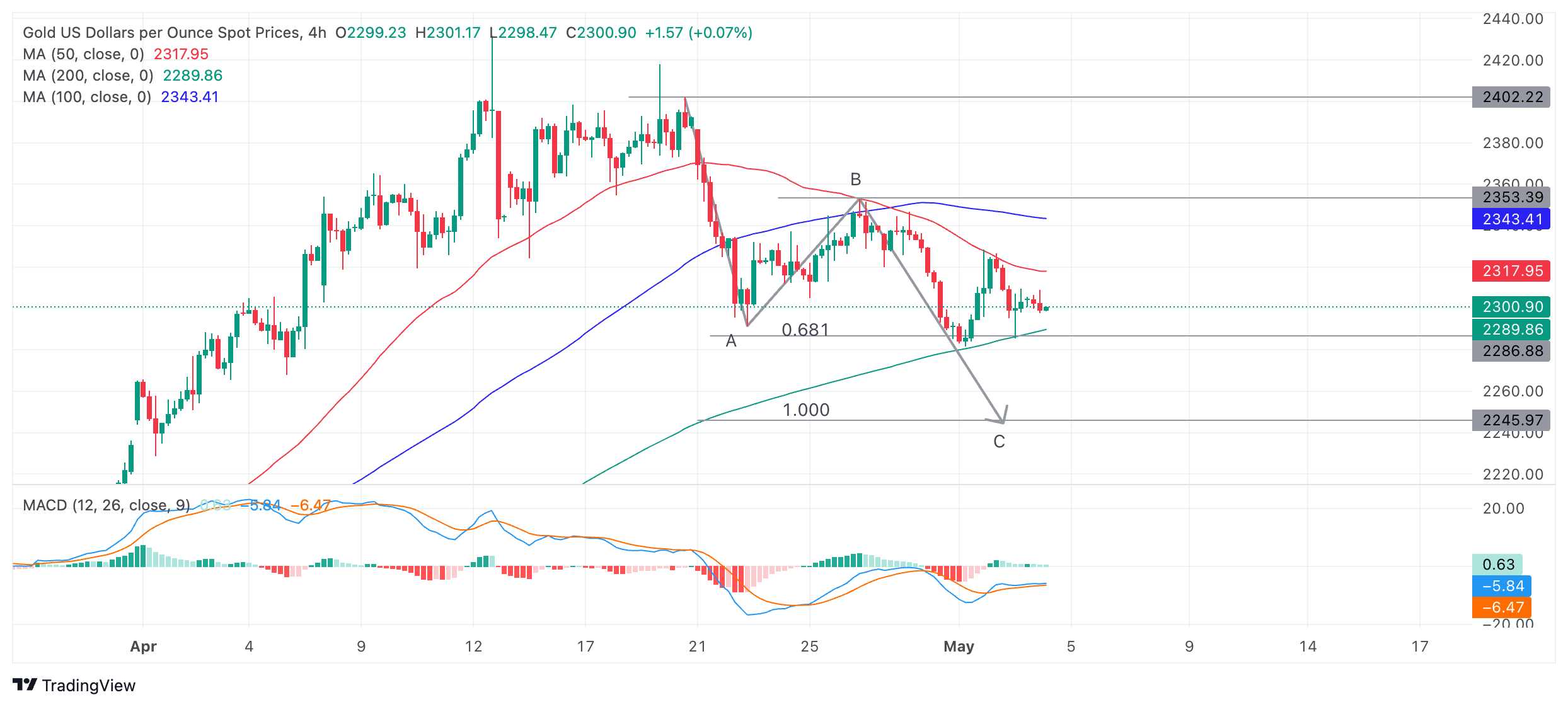Gold price fluctuates lower on declining safe-haven demand
- Gold price edges lower as safety demand lessens amid market good cheer.
- A feel-good factor has set in following the Fed’s slightly dovish messaging on Wednesday.
- Gold price lurches sideways as traders tense, poised for the release of the US Nonfarm Payroll labor report.
The Gold price (XAU/USD) edges lower on Friday, trading down to just above $2,300, as safe-haven demand for the precious metal diminishes amid an overall upbeat market mood.
Gold price fluctuates lower as safe-haven demand softens
Gold price fluctuates lower as market sentiment remains positive on Friday, tempting investors away from the safe and secure. Asian stocks followed Wall Street higher overnight after investor fears that the Federal Reserve (Fed) might threaten to raise interest rates eased.
The Fed’s May policy meeting on Wednesday reflected an easing bias amongst Fed committee members who decided to slow down quantitative tightening by reducing their holdings of US Treasuries at a slower rate. In his press conference after the meeting, Federal Reserve Chairman Powell also stated that it was “unlikely” the central bank would raise interest rates despite persistent inflation.
Whilst expectations that US interest rates are not likely to rise helped Gold price immediately after the meeting because of its condition as a non-yielding asset, the good feeling that followed in broader global markets curtailed a key source of demand for the precious metal as a safe store of value.
Investors now await key data out on Friday in the form of the US Nonfarm Payrolls (NFP) labor report for April, which could tone the outlook for the US economy and impact continued concerns around inflation.
If the NFP shows a higher-than-expected number of nonfarm workers joined the ranks of the employed in the US in April, or if wages are shown to have risen sharply, it could change the outlook for inflation and interest rates.
Economists’ expectations are for NFPs to come in at 243K from 303K in March, and for Average Hourly Earnings to rise by 0.3% MoM and 4.0% YoY. A marked rise – especially in these two metrics – could cause downside volatility for Gold price, and vice versa for a fall.
Technical Analysis: Gold price tracks sideways ahead of NFPs
Gold price (XAU/USD) appears to be tracking sideways on the 4-hour Chart. It has stopped declining after meeting the conservative requirement for completing its bearish Measured Move price pattern at the Fibonacci 0.681 price objective for wave C, at $2,286.
XAU/USD 4-hour Chart
The Measured Move, a zig-zag type pattern, could still unfold if wave C has lower to go. Although it has met its conservative objective at the 0.681 Fibonacci target, it could still fall to a second target at the point where wave C equals the length of wave A. Alternatively, it may have finished unfolding altogether – both outcomes are possible.
Directionally, Gold is in a bit of a no-man’s land: a break below the 0.681 Fibonacci target lows at $2,285 would be needed to confirm more downside to a target at $2,245 (1.000 or where A=C).
Alternatively, a break above the cluster of Moving Averages and the peak of wave B at around $2,350 would potentially usher in a new more bullish environment. This could then see a retest of the $2,400 highs.
Additionally, the trend for Gold price is up on both the medium and long-term charts (daily and weekly), overall supporting the outlook on lower time frames.
Gold FAQs
Gold has played a key role in human’s history as it has been widely used as a store of value and medium of exchange. Currently, apart from its shine and usage for jewelry, the precious metal is widely seen as a safe-haven asset, meaning that it is considered a good investment during turbulent times. Gold is also widely seen as a hedge against inflation and against depreciating currencies as it doesn’t rely on any specific issuer or government.
Central banks are the biggest Gold holders. In their aim to support their currencies in turbulent times, central banks tend to diversify their reserves and buy Gold to improve the perceived strength of the economy and the currency. High Gold reserves can be a source of trust for a country’s solvency. Central banks added 1,136 tonnes of Gold worth around $70 billion to their reserves in 2022, according to data from the World Gold Council. This is the highest yearly purchase since records began. Central banks from emerging economies such as China, India and Turkey are quickly increasing their Gold reserves.
Gold has an inverse correlation with the US Dollar and US Treasuries, which are both major reserve and safe-haven assets. When the Dollar depreciates, Gold tends to rise, enabling investors and central banks to diversify their assets in turbulent times. Gold is also inversely correlated with risk assets. A rally in the stock market tends to weaken Gold price, while sell-offs in riskier markets tend to favor the precious metal.
The price can move due to a wide range of factors. Geopolitical instability or fears of a deep recession can quickly make Gold price escalate due to its safe-haven status. As a yield-less asset, Gold tends to rise with lower interest rates, while higher cost of money usually weighs down on the yellow metal. Still, most moves depend on how the US Dollar (USD) behaves as the asset is priced in dollars (XAU/USD). A strong Dollar tends to keep the price of Gold controlled, whereas a weaker Dollar is likely to push Gold prices up.







